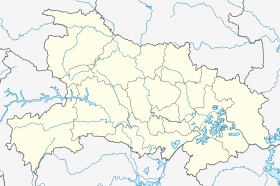Yunyang District
Yunyang District (simplified Chinese: 郧阳区; traditional Chinese: 鄖陽區; pinyin: Yúnyáng Qū), formerly Yun County or Yunxian (simplified Chinese: 郧县; traditional Chinese: 鄖縣; pinyin: Yún Xiàn),[1][3] is a district of the prefecture-level city of Shiyan in northwestern Hubei Province, China. It borders the provinces of Henan (to the northeast) and Shaanxi (to the north and west). The district spans an area of 3,863 square kilometers, and has a population of 558,355 as of 2010.[1][2]
Yunyang 郧阳区 | |
|---|---|
District | |
 Yunyang Location in Hubei | |
| Coordinates (Yunyang government): 32°50′05″N 110°48′43″E | |
| Country | People's Republic of China |
| Province | Hubei |
| Prefecture-level city | Shiyan |
| Area | |
| • Total | 3,863 km2 (1,492 sq mi) |
| Population (2010)[2] | |
| • Total | 558,355 |
| • Density | 140/km2 (370/sq mi) |
| Time zone | UTC+8 (China Standard) |
| Website | www |
In 1992 crania of a species of Homo were found, dated to 900,000 years ago, and showing features of both Homo erectus and Homo sapiens.[4][5]
Geography
Approximately 60% of the district is forested.[1]
The Han River runs through the district, as well as its tributary Du River, and the Tao River.[1][6]
Administrative divisions
The district administers 16 towns, 3 townships, and 1 township-level forestry area.[1][2][7]
The district's 16 towns are Anyang, Yangxipu, Qingqu, Baisangguan, Nanhuatang, Bailang, Liudong, Tanshan, Meipu, Qingshan, Chadian, Liubei, Baoxia, Hujiaying, Tanjiawan, and Chengguan.[2][7]
The district's 3 townships are Daliu Township, Wufeng Township, and Yeda Township.[2][7]
The district also administers the Hongyanbei Forestry Area (红岩背林场), which operates as a township-level division.[2][7]
Economy
As of 2016, there were 461,100 people living in agrarian households throughout the district.[8] The district is home to 663 agricultural businesses, including 183 agricultural co-operatives.[8] Cultivated land in the district totaled 611,500 mu as of 2016.[8] 96.4% of the district's agricultural production is crop farming, with forestry, animal husbandry, aquaculture, and agricultural services comprising the remaining 3.6%.[8] The living conditions of the district's agrarian population varies greatly, and substandard living conditions are not uncommon. 21.3% of the district's agrarian population lives in bamboo structures, 44.4% of the district's agrarian population does not source their water from protected sources, 90.8% of agrarian households report frequently using firewood for energy needs, 87.4% of the agrarian population does not have access to flush toilets, and the majority of agrarian households do not have access to air conditioning or computers.[8]
100% of the district's villages have access to electricity and landlines, 90.7% have cable TV installed, and 88.4% have access to broadband.[8]
Transportation
The Xiangyang–Chongqing railway passes through the district.[6]
References
- 郧阳区情简介 [Yunyang District Overview] (in Chinese). Yunyang District People's Government. Archived from the original on 2020-07-15. Retrieved 2020-07-15.
- 郧阳区历史沿革 [Yunyang District Historical Development] (in Chinese). XZQH.org. 2014-09-25. Archived from the original on 2020-07-15. Retrieved 2020-07-15.
- 現代漢語詞典(第七版 [Contemporary Chinese Dictionary] (7th ed.). The Commercial Press. 1 September 2016. p. 1622. ISBN 978-7-100-12450-8.
郧(鄖) Yún 1 郧县,地名,在湖北。{...}
- Kate Douglas (May 5, 2018). "Our Asian Origins". New Scientist.
- Li, T (Jun 4, 1992). "New Middle Pleistocene hominid crania from Yunxian in China". Nature. 357: 404–7. doi:10.1038/357404a0. PMID 1594044.
- 郧阳区概况地图 [Yunyang District Overview Map] (in Chinese). XZQH.org. 2014-09-25. Archived from the original on 2020-07-15. Retrieved 2020-07-15.
- 2019年统计用区划代码. stats.gov.cn (in Chinese). National Bureau of Statistics of the People's Republic of China. 2019. Archived from the original on 2020-07-15. Retrieved 2020-07-15.
- 十堰市郧阳区第三次全国农业普查情况汇报 (in Chinese). Yunyang District People's Government. 2018-08-28. Archived from the original on 2020-07-15. Retrieved 2020-07-15.